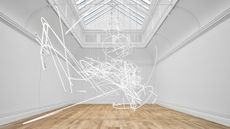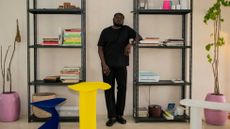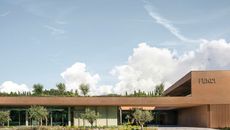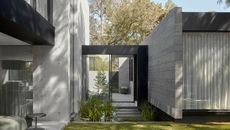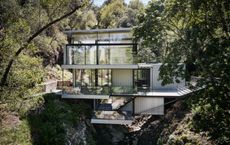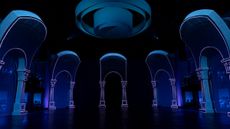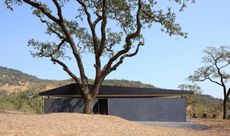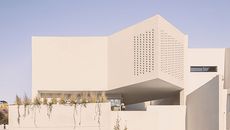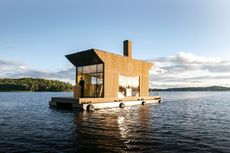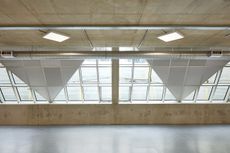Suspension House spans a creek in the Californian hills
Anne Fougeron has remodelled an existing house into a striking new Californian home that combines classic modernist aesthetics with a very contemporary respect for the landscape
- (opens in new tab)
- (opens in new tab)
- (opens in new tab)
- Sign up to our newsletter Newsletter

The Suspension House is one of those rare architectural statements that only comes along once in a generation. The combination of site, vision, and skill is so often squandered, but San Francisco-based architect Anne Fougeron has translated her clients’ desires into spectacular reality, respecting the wildness of the site without compromising on the clarity of the design.

The existing house occupies the kind of site that is not only rare but actually forbidden (California no longer allows homes to be built across a creek), so Fougeron and her team had to make the most of the opportunity. The original house had to be retrofitted with new structure to support the load of the new additions, all while touching only lightly on the ground.

‘A man-made object in nature may exist in harmony or disparity,’ Fougeron points out, ‘The goal was to reconnect this structure into the environment while best utilizing the exceptional site for the clients.’ The law dictated that the new structure had to follow the exact outline of the original house, which luckily included three generous outdoor areas.

A carefully planned structural system allowed the mass of the original house to be expanded with a new upper floor, rotated 90 degrees to the main structure. Whereas the first house was supported by columns that were driven into the creek bed, the architects and engineers came up with a suspension bridge-type structure slung between the two slopes. This allowed the water to run impeded beneath the house.

The proximity to water has been exploited at every conceivable occasion. With structural elements and fixtures like the staircase and kitchen finished in dark colours and floors, ceilings, and internal wall planes in white, the house is set up as a simple, unassuming frame to the wilderness beyond.

Transparent materials are used throughout, including floor-to-ceiling windows, glass doors and balustrades, and open tread staircases, ensuring that the verdant cliffs, surrounding forest and running water are felt from every room in the house.

The house is entered from the second floor via a walkway threaded through the forest, with an open plan living and dining space occupying the entire level. Decks at front and rear overlook the creek, which runs east-west beneath the house.

A guest suite with its own private deck is located on the bottom-most floor, along with utility areas, while the primary bedroom suite is set within the new third floor. Up here there’s another bedroom and flexible space, with a new roof terrace opening off the largest bedroom.

A separate guest house is located alongside the path to the main house, with black cladding to distinguish it, and a sleeping platform and galley kitchen.

Not many houses have a waterfall in their backyard - a certain Fallingwater by Frank Lloyd Wright springs to mind. Fougeron describes the project as a house that ‘balances the role of architecture - especially modernism - in nature with the role of the client to their home,’ and the end result certainly meets the challenge.
The architect set up her studio in 1985 and has won multiple awards. Previous projects include the Fall House in Big Sur and a collaboration with OMA on The Avery tower in San Francisco. §


INFORMATION
Fougeron.com (opens in new tab)
Jonathan Bell has written for Wallpaper* magazine since 1999, covering everything from architecture and transport design to books, tech and graphic design. He is now the magazine’s Transport and Technology Editor. Jonathan has written and edited 15 books, including Concept Car Design, 21st Century House, and The New Modern House. He is also the host of Wallpaper’s first podcast.
-
 Cerith Wyn Evans: ‘I love nothing more than neon in direct sunlight. It’s heartbreakingly beautiful’
Cerith Wyn Evans: ‘I love nothing more than neon in direct sunlight. It’s heartbreakingly beautiful’Cerith Wyn Evans reflects on his largest show in the UK to date, at Mostyn, Wales – a multisensory, neon-charged fantasia of mind, body and language
By Harriet Lloyd-Smith • Published
-
 Nifemi Marcus-Bello is the Nigerian designer shaping Africa’s designscape
Nifemi Marcus-Bello is the Nigerian designer shaping Africa’s designscapeAmong Wallpaper’s ‘Future Icons’, Lagos-based designer Nifemi Marcus-Bello speaks of creating a local manufacturing network and documenting design production in Africa
By Ugonna-Ora Owoh • Published
-
 Luxury loungewear brands to hibernate in this winter
Luxury loungewear brands to hibernate in this winterAs days get shorter and temperatures drop, we present the best loungewear for luxuriating in this autumn and winter, from brands including Loro Piana, Raey, Extreme Cashmere and more
By Tilly Macalister-Smith • Published
-
 The Fendi factory in Tuscany disappears into the landscape
The Fendi factory in Tuscany disappears into the landscapeThe new Fendi Factory in Italy, set in the rolling hills of Tuscany, is the brainchild of Milan architecture studio Piuarch and the luxury brand
By Ellie Stathaki • Published
-
 Park House is a minimalist, art-filled family home in Melbourne
Park House is a minimalist, art-filled family home in MelbournePark House by Mim Design and Pleysier Perkins is an art-filled family home in Melbourne including a bold, concrete extension
By Nick Compton • Published
-
 Year in review: top 10 houses of 2022, selected by Wallpaper* architecture editor Ellie Stathaki
Year in review: top 10 houses of 2022, selected by Wallpaper* architecture editor Ellie StathakiWallpaper’s Ellie Stathaki reveals her top 10 houses of 2022 – from modernist reinventions to urban extensions and idyllic retreats
By Ellie Stathaki • Published
-
 Stage architecture, from Disney to dance
Stage architecture, from Disney to danceClever stage architecture makes or breaks a cultural experience – from Yellow Studio’s set for Disney’s new live-action Beauty and the Beast, to more immersive structures in the genre
By Martha Elliott • Published
-
 This bijou Sonoma County house is in sync with the landscape
This bijou Sonoma County house is in sync with the landscapeAn open and contextual Sonoma County house, Leit House is designed by San Francisco’s Schwartz and Architecture
By Ellie Stathaki • Published
-
 Minimalist architecture: homes that inspire calm
Minimalist architecture: homes that inspire calmThese examples of minimalist architecture place life in the foreground – clutter is demoted; joy promoted. Elevating interiors to places of peace, these buildings created by design pioneers help us to trace a recent history of minimalism in home design.
By Ellie Stathaki • Published
-
 Big Branzino sauna floats in the Stockholm archipelago
Big Branzino sauna floats in the Stockholm archipelagoThe Big Branzino floating sauna by Sandellsandberg opens to guests in the Stockholm archipelago
By Ellie Stathaki • Published
-
 Twin 6a architects buildings arrive at London Design District
Twin 6a architects buildings arrive at London Design DistrictTwo 6a architects-designed buildings, A2 and B2, launch at the Design District in London
By Ellie Stathaki • Last updated
